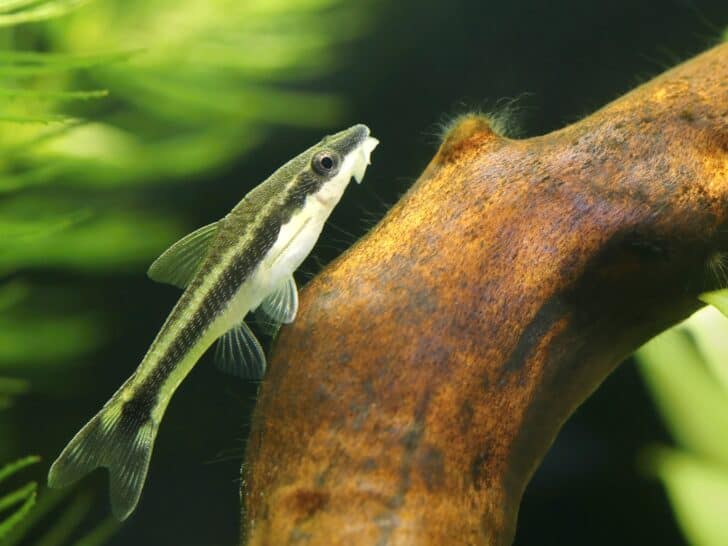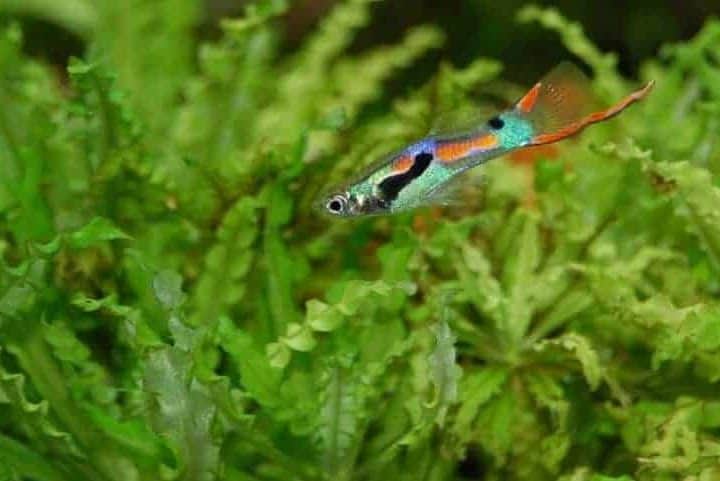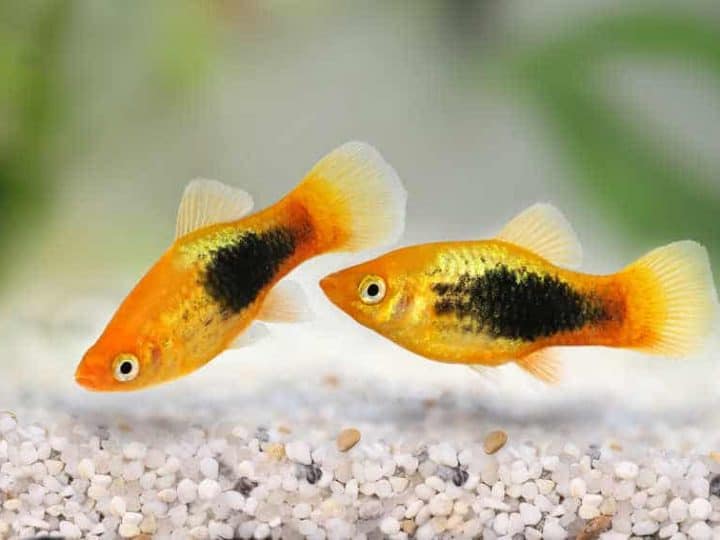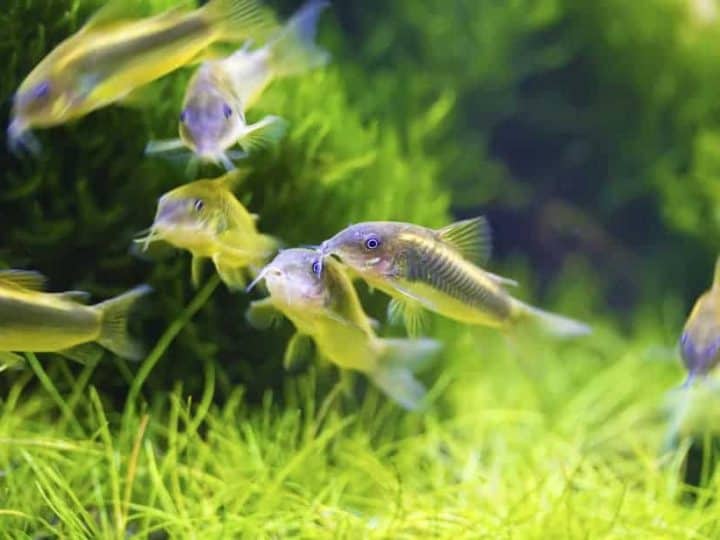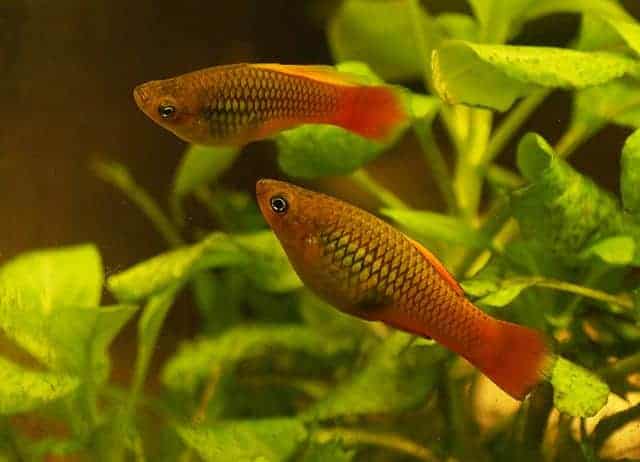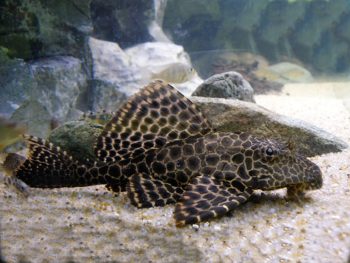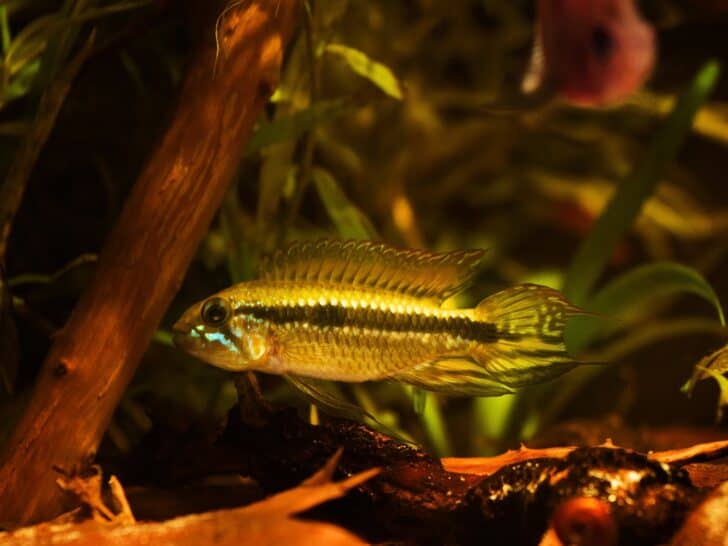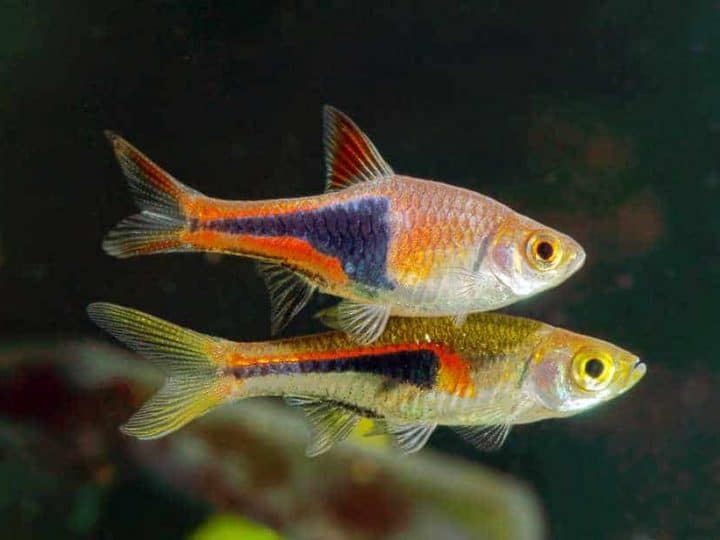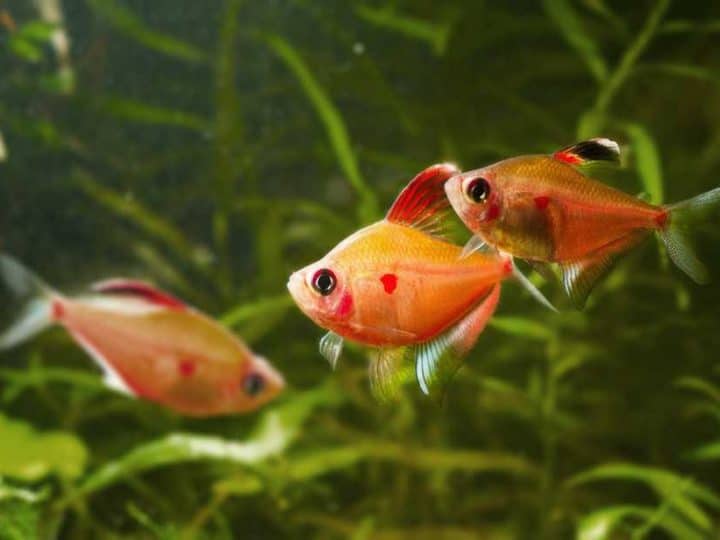Building a tank with a strong current can be tricky since it’s challenging to find reliable resources on the types of fish that enjoy fast-flowing water. Still, plenty of fish out there love to fight the current and have naturally adapted to live in strong waters. The following are aquarium fish that like high flow.
Some of the best aquarium fish that like high flow include hillstram loaches, whitecloud mountain minnows, danios, rasboras, hatchetfish, golden barbs, and flying fox fish, among others.
These fish don’t just tolerate a strong current, but they rely on one to stay happy and healthy. So, let’s talk more about these stunning fish and discuss what each of them requires so that you can build up your tank with fish that are well-suited to live together in forceful water.
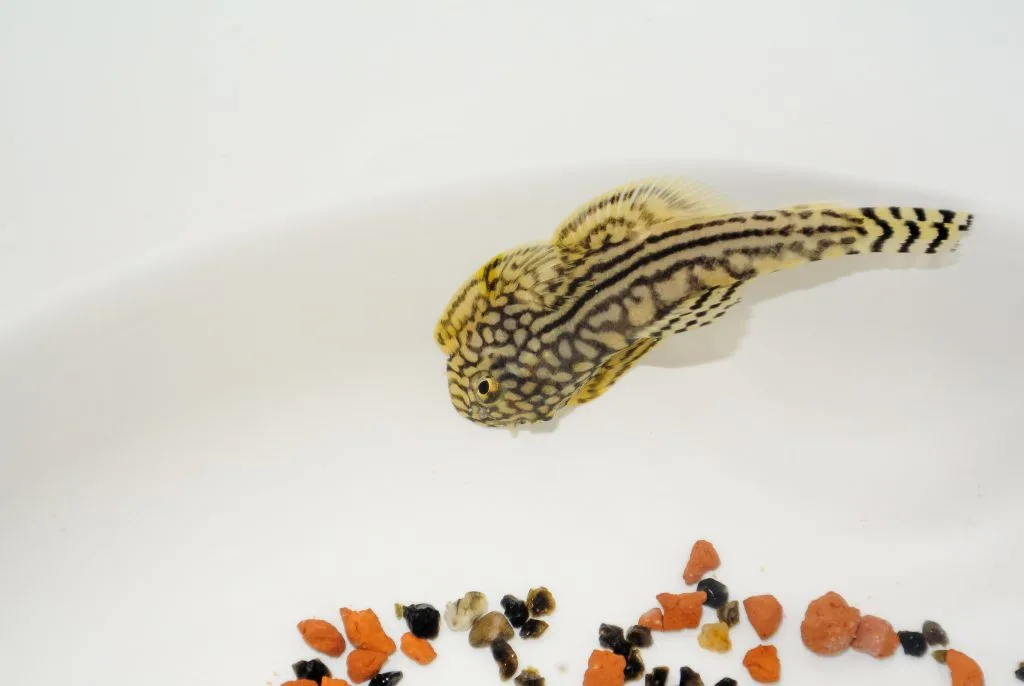
1. Hillstream Loaches
Size: 2 to 3 Inches (5 to 7.6 cm)
Tank Level: Bottom
Diet: Omnivorous
Optimal Temperature: 68°F to 75°F ( 20° C to 24º C)
Life Expectancy: 8 to 10 years
Hillstream loaches are a favorite strong-current freshwater aquarium fish among aquarists all over the world. They tolerate very harsh water conditions due to their torpedo-like shape and incredible rock-grappling strength.
These bottom-feeders, native to Asia, often live in streams and rivers with high currents. To help them fight the current, they have a smooth, hydrodynamic body that keeps them in place, no matter how hard the water pushes against them.
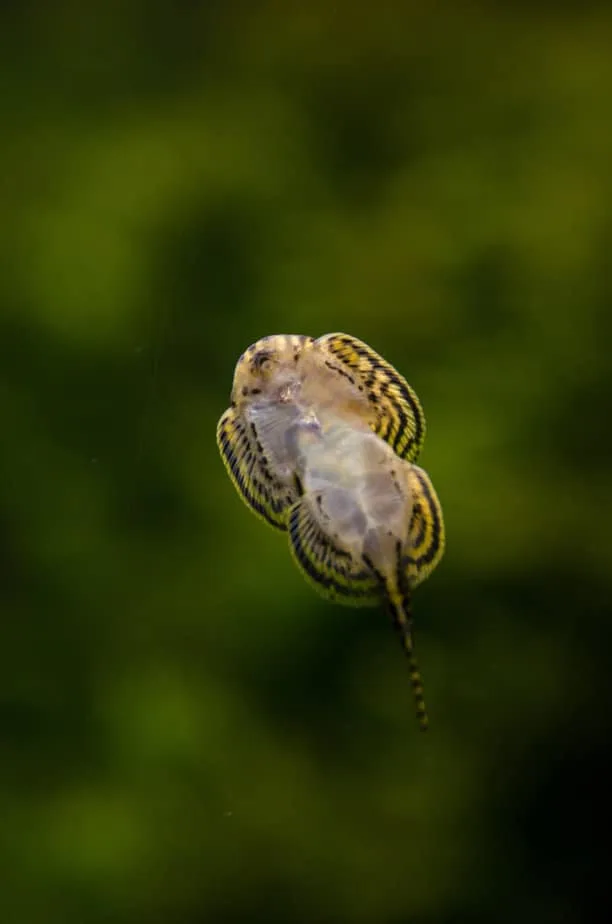
Because of their appearance, they look like a catfish-stingray hybrid, but they’re true loaches.
These loaches are a very hearty species, and they tolerate many different conditions, although they prefer warmer water and a high-flowing current.
Although hillstream loaches are omnivorous, they’re friendly and won’t attack your fish. They’re also scavengers, so they might help you keep your tank clean from excess food and algae. You might also like the Kuhli loach!
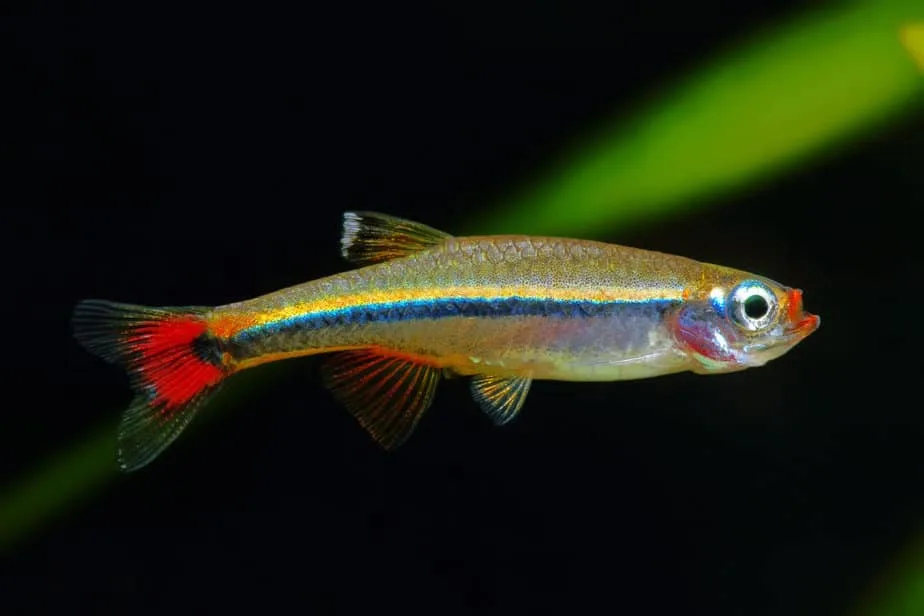
2. Whitecloud Mountain Minnows
Size: 1 to 2 inches (about 3 cm)
Tank Level: Top and Middle
Diet: Omnivorous
Optimal Temperature: 60º to 72° F (15º to 22° C)
Life Expectancy: 4 to 5 years
White cloud mountain minnows, native to China and Vietnam, are peaceful school fish. They naturally live in mountain streams where the current is high. Because they naturally live at high elevations, they prefer colder water.
These minnows appreciate a moderate to high-speed current, so they do best when you have plenty of “normal flow” resting spots in your tank for them to take a break. That’s because they often live in streams with a high flow, but they usually sleep in areas where the land blocks the current.
The minnows are stunning, and they look much like neon tetras. They have an iridescent glow with a red stripe running from their tails to their heads. They also have one black dot near the base of their tail, which can help you identify them.
These minnows can get along with anyone, which is one of their significant appeals. They generally eat small invertebrates and some plant matter. So, you can feed them standard tropical flakes, brine shrimp, daphnia, or crushed bloodworms.
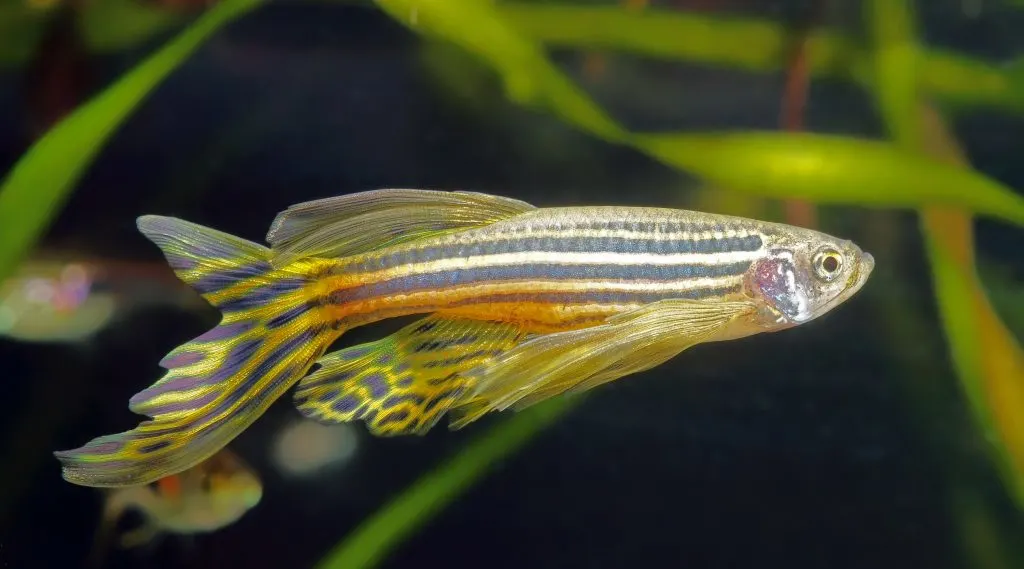
3. Danios
Size: 1.5 to 2 inches (3.8 to 5 cm)
Tank Level: Top to Middle
Diet: Omnivorous
Optimal Temperature: 70° to 78° F (21º to 26º F)
Life Expectancy: 3 to 5 years
Because danios are incredibly friendly, beautiful, and resilient fish, they’re some of the most popular fish for any tank. Danios are native to southern Asia, where they live in freshwater streams.
These school fish like to live in strong currents near the surface, where they’re very active. Danios love to play fast-flowing water, and since they’re very energetic, they can be pretty fun to watch.
One of the most popular varieties of danios includes the zebra danio. Zebra danios are the most striking in appearance, and they have black stripes and iridescent bodies with golden tails and fins that look spectacular, especially when they swim in schools.
Danios are friendly fish, and they hardly ever attack others which is another reason for their popularity among aquarists. They eat small invertebrates such as bloodworms, daphnia, and shrimp. So, any omnivorous tropical flake will do for these hearty fish.
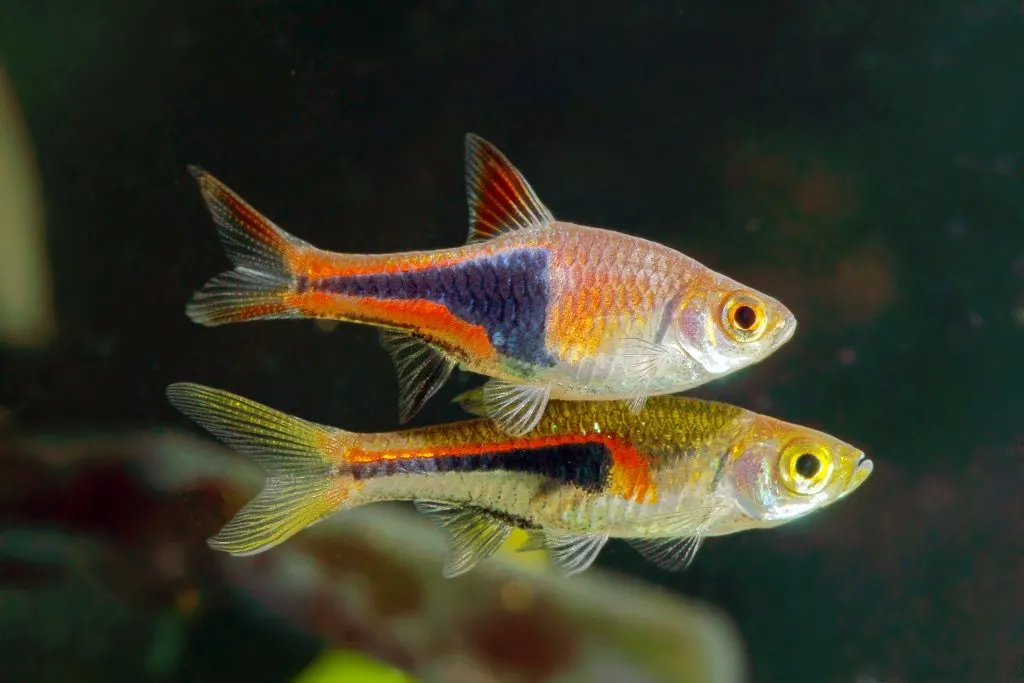
4. Rasboras
Size: 2 inches (5 cm) or less
Tank Level: Top
Diet: Omnivorous
Optimal Temperature: 72° F to 80° F (22º to 27º C)
Life Expectancy: 5 to 8 years
Rasboras are hearty school fish that do well in almost any tank. They’re peaceful and hard to kill, and they’re also very playful.
Naturally, these fish live in many conditions, from ponds to rivers. They need a medium-current place to rest in a strong current tank, but they’ll go wild in the high-current areas, often treating the water like a treadmill.
Most varieties of rasboras do very well in high-current tanks, but some of the most active stunning rasboras are the harlequin variety. These hearty stream-living fish are incredibly vibrant and beautiful to look at.
Harlequin rasboras have a golden color to their fins, and their bodies are a silvery metallic color. They have a characteristic triangular-shaped black spot that extends down their tails, which is the marking that gives them their names.
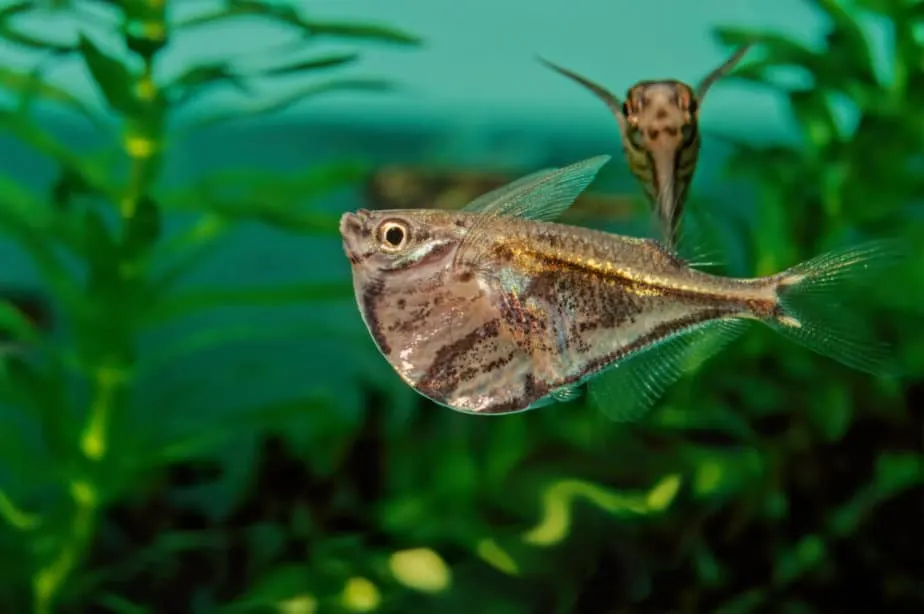
5. Hatchetfish
Size: 2 inches (5 cm)
Tank Level: Top
Diet: Carnivorous
Optimal Temperature: 72º to 80º F (22º to 27º C)
Life Expectancy: 5 years
In my opinion, hatchet fish are the absolute best top-level schooling fish out there. They’re gorgeous, peaceful, and easy to please, making them the perfect fish for community tanks and beginners.
Hatchet fish have thin, coin-like bodies that they use to hover in strong currents and travel at surprisingly swift speeds. They naturally live in streams, rivers, and swamps in South and Central America, and they’re incredibly versatile.
There are several varieties of hatchet fish, but all of them have gorgeous, silvery iridescent bodies that make for a fantastic, reflective display. Their bellies look distended, giving them the shape of an ax-head, while their bodies are skinny.
Their fins function like wings to help them move quickly in the water and hover mid-current, but they can also use them to catch some air, so be sure that your tank has a lid to keep these guys in.
Hatchetfish are carnivores, and they primarily eat insects and small invertebrates in the wild. They appreciate bloodworms and other insects as treats, and you should generally feed them flakes with plenty of protein.
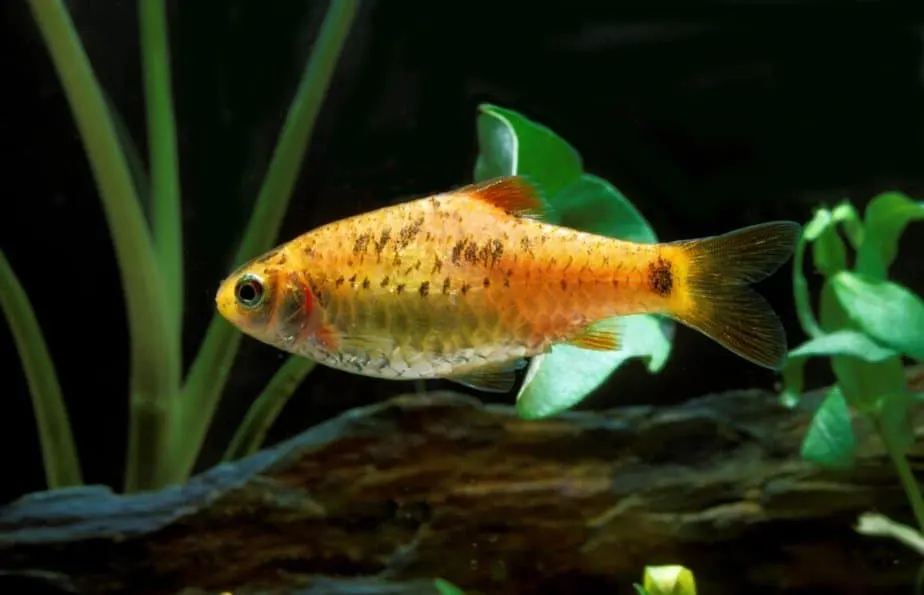
6. Gold Barbs
Size: 3 inches (7.6 cm)
Tank Level: Top
Diet: Omnivorous
Optimal Temperature: 70º to 77º F (21º to 25º C)
Life Expectancy: 5 to 7 years
Gold barbs are hearty schooling fish from China, where they live in strong-current streams.
Barbs are generally peaceful fish, but they can be territorial, so they do better with fish that aren’t aggressive. Danios do very well with these fish since they’re so kind and passive.
Gold barbs can add a pop of bright color to your tank with their mottled golden-orange scales and fins. Gold barbs have some dark spots on their bodies, which adds contrast to their brilliant hues.
They’re resilient, so they’re perfect for beginners and people who want a passive tank. They’re also very active, so plan to be entertained with these brilliant fish! Tiger barbs are another option to consider.
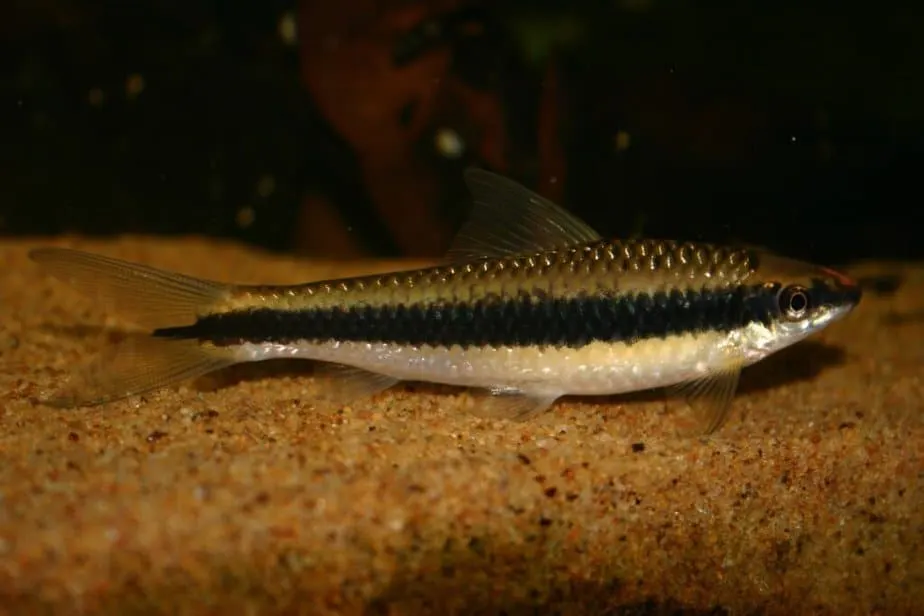
7. Flying Fox Fish
Size: up to 6 inches (15 cm) long
Tank Level: Bottom
Diet: Omnivorous
Optimal Temperature: 68º to 79º F (20º to 26º F)
Life Expectancy: 5 to 8 years
Flying fox fish live in free-flowing rivers in southeastern Asia, making them a perfect fish for strong-current tanks. They have long, flat bodies with one dark stripe running down the middle. They also have semi-transparent fins and a stunning radiance that makes them a pleasure to behold.
These fish can get long, so they’re not ideal for smaller tanks. However, you should only have one flying fox at a time since they can be aggressive to other members of their species. They may also bully other bottom-dwellers, so you might not want to put them in a tank with loaches, plecos, or cory catfish.
Flying fox fish prefer to eat vegetation, but they do need the occasional meat treat. They’ll eat a small amount of protein-rich flakes or insects like worms and larvae, but they generally get most of their nutrition from algae and plant matter.
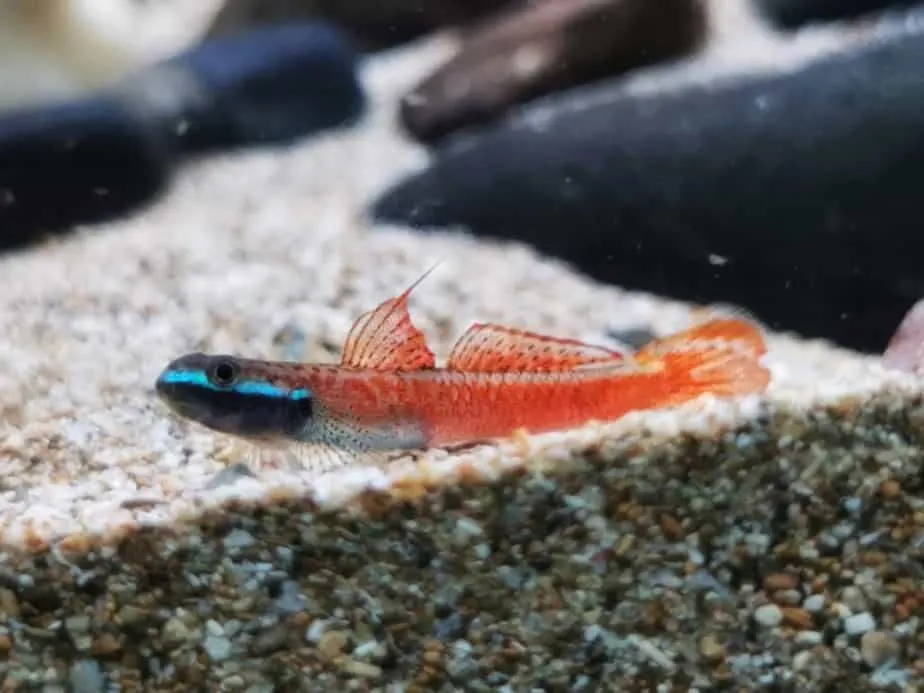
8. Red Neon Stiphodon Goby
Size: 1.5 to 2 inches (4 to 5 cm)
Tank Level: Bottom
Diet: Omnivorous (with a strong preference for biofilm)
Optimal Temperature: 68° to 82° F (20° to 27° C)
Life Expectancy: 1 to 2 years
The red neon goby, also known as the red neon Stiphodon goby, is a rare freshwater goby native to high-current rivers and streams in Japan and the Philippines. They’re peaceful and small but have brilliant colors that make them a stunning addition to any tank.
Male red neon Stiphodon gobies have a stunning warm golden-red color with bright white spots and stripes and an iridescent blue head. The females are far less colorful, with black and white stripes.
Other Stiphodon gobies, such as the rainbow and neon blue goby, also do well in strong-current freshwater tanks, but I always opt for the male red neon goby since it is simply stunning!
Red neon gobies do particularly well with other peaceful, strong-current fish such as loaches and danios.
These omnivores have been known to accept the occasional protein, but they heavily rely on algae and biofilm to stay healthy, so they are a great last addition to a heavily planted tank.
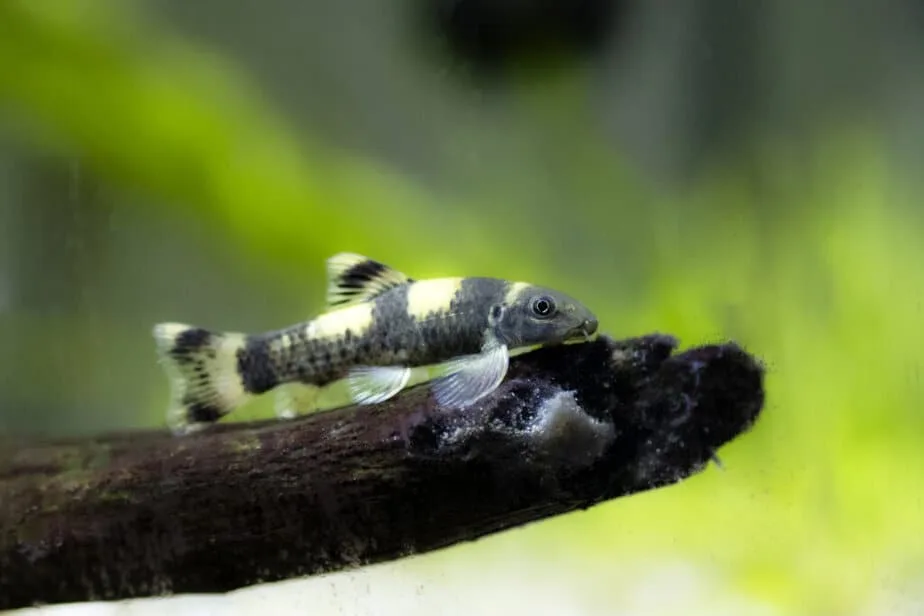
9. Panda Garra
Size: 2.5 to 3.5 inches (6 to 8 cm)
Tank Level: Middle to Bottom
Diet: Omnivorous
Optimal Temperature: 70º to 77° F (21º to 25° C)
Life Expectancy: 4 to 6 years
Panda Garra fish, also called panda flavatra, are docile, active, and stunning, and they love a strong-current fish tank. These bottom to middle-level fish have a suctorial disk and bottom fins that keep them from floating away in their native fast-flowing streams and rivers in Myanmar.
These adorable fish are predominantly black with some yellow-orange and light brown stripes. They have broad heads with narrow bodies, which gives them an appealing appearance.
These fish are always on the move, which makes them very entertaining fish to watch. They often interact with humans, and mine always likes to pop up and visit me when I get near the tank.
Panda Garra can be aggressive to others of their kind, but they never really do any damage. Still, to avoid stress, I recommend keeping only one at a time.
These fish double as cleaners and active tank fish, so I love to keep them in my strong-current builds.
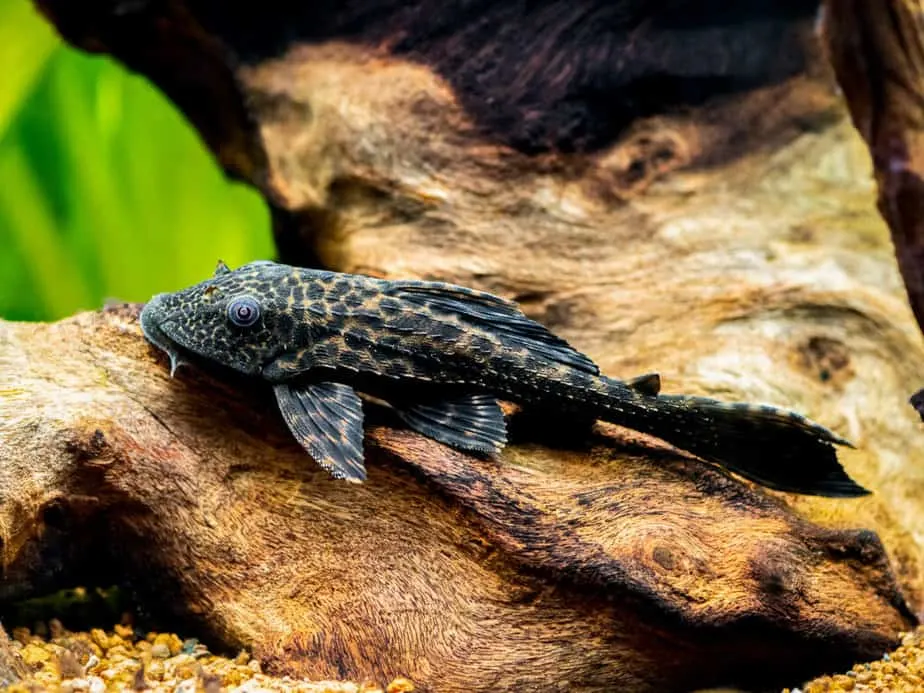
10. Plecos
Size: Various
Tank Level: Bottom
Diet: Omnivorous
Optimal Temperature: 74° to 80° F (23º to 27º C)
Life Expectancy: 10 to 15 years
Plecos are your do-it-all cleaner fish, and with their heartiness, peacefulness, and versatility, it isn’t hard to see why.
These South American bottom-feeders have giant mouths and suctorial disks that allow them to trace the edges of your tank, cleaning as they go.
Common plecos have a light brown body with dark peaks and spots and flowing, fan-like fins, making them look a bit like a fishy leopard. However, many varieties have more stunning colors, such as white with black stripes, bright white spots, or yellow polka-dots.
Although plecos predominantly eat algae and biofilm, they will eat some insects, worms, and leftover flakes at the bottom of the tank.
Still, it’s crucial to get the right pleco for your tank. Some plecos can reach huge sizes of more than 12 inches (30.5 cm) long!
However, some of the best plecos for mid-size or community tanks are zebra, pitbull, clown, leopard frog, and gold spot dwarf plecos. Always check with your fish seller before buying a pleco to check the expected growth size before buying one.
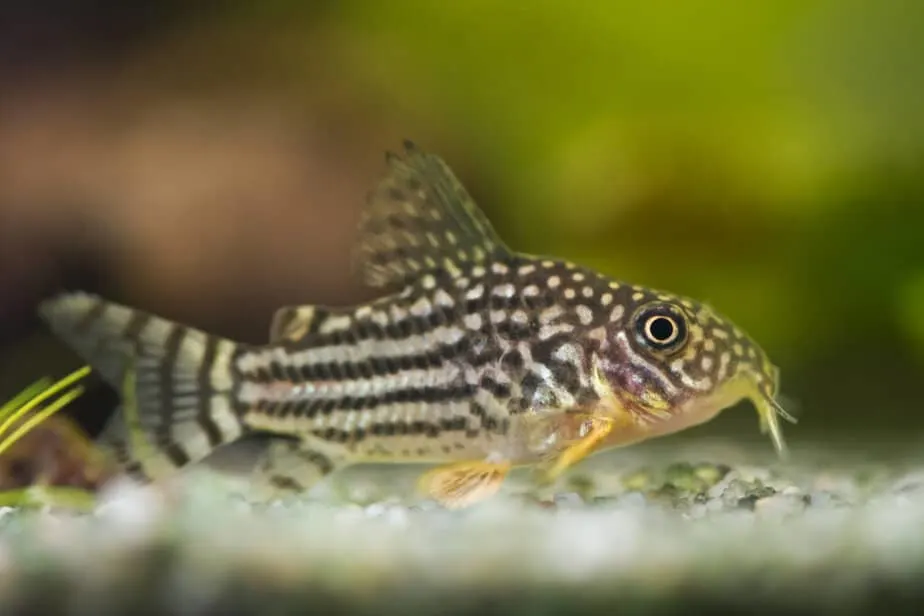
11. Cory Catfish
Size: 1 to 3 inches (2.5 to 7.6 cm)
Tank Level: Bottom
Diet: Omnivorous
Optimal Temperature: 74° to 80° F (23º to 27º C)
Life Expectancy: 5 years
Cory catfish, short for Corydoras catfish, are peaceful bottom feeders with a signature whiskered appearance. They naturally live at the bottom of streams and rivers, feeding on invertebrates and plant matter.
Cory catfish never get too large, which makes them an ideal community tank fish. These catfish come in various colors, from white to iridescent to spotted, so there’s always a cory for everyone’s taste. My favorite is the masked Corydoras, which is white with a black stripe over its eyes, making it look like a tiny aquatic bandit.
Cory catfish like to have buddies, so they do best with three or more in a tank. Some varieties will shoal in the middle of the tank, while others will stick to the bottom layer.
These sweet little guys won’t pick a fight, so they do well with other non-aggressive fish such as danios, minnows, rasboras, hatchet fish, panda Garra, and gobies.
How to Increase the Flow Rate in an Aquarium
So, if you’re looking for fish that enjoy high flow rates in the aquarium, then something you might be wondering is how to increase that flow rate.
Well, one of the only effective ways to increase the flow rate or current in an aquarium is to add more water pumps and powerheads. It’s one of the best ways to recreate the natural habitate of various freshwater fish that enjoy stronger currents.
Power heads are ideal as you can direct them in various directions, and adjust the flow as well. If you want to recreate the natural motion of water, using something like a wavemaker may also be an option.
Remember however, don’t create too high of a current, particularly when directed at the substrate or towards delicate plants. You want there to be a good current in the water without disturbing the plants and substrate, or else your snails might go flying all over the place!

